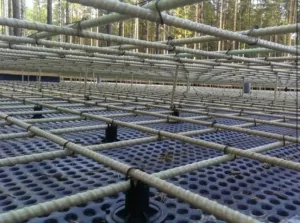Introduction
In the challenging climate of Canada, where extreme temperatures, freeze-thaw cycles, and corrosive elements are common, it is crucial to use construction materials that can withstand these harsh conditions. Fiberglass rebar has emerged as an excellent alternative to traditional steel reinforcement, offering numerous advantages in Canada’s demanding environment. This article Unicomposite pultruded profiles explores the benefits of fiberglass rebar and its suitability for the country’s harsh climate.

fiberglass rebar canada
1. What is Fiberglass Rebar?
Fiberglass rebar, also known as FRP (Fiber Reinforced Polymer) rebar, is a composite material made from glass fibers and a polymer resin matrix. It is a lightweight and corrosion-resistant alternative to traditional steel reinforcement. The material’s strength and durability make it an ideal choice for construction projects in Canada’s harsh climate.
2. Durability and Strength in Harsh Climates
Fiberglass rebar exhibits exceptional durability and strength, even in extreme weather conditions. Unlike steel rebar, it does not corrode, rust, or deteriorate when exposed to moisture, deicing salts, or chemicals. This characteristic ensures the longevity of structures in Canada’s harsh climate, reducing the need for frequent repairs and replacements.
3. Corrosion Resistance
One of the significant advantages of fiberglass rebar is its excellent resistance to corrosion. In Canada, where deicing salts are commonly used on roads and bridges, the corrosive nature of traditional steel reinforcement poses a significant challenge. Fiberglass rebar does not corrode, ensuring the structural integrity of concrete elements over the long term.
4. Thermal Expansion and Contraction
Canada’s climate experiences drastic temperature changes throughout the year, causing materials to expand and contract. Fiberglass rebar has a lower coefficient of thermal expansion than steel rebar, making it better suited for Canada’s freeze-thaw cycles. This characteristic reduces the risk of cracking and structural damage in concrete elements.
5. Lightweight and Easy to Handle
Compared to steel rebar, fiberglass rebar is significantly lighter. This lightweight nature simplifies transportation, handling, and installation processes. Construction workers can carry and maneuver fiberglass rebar with ease, reducing labor requirements and increasing overall efficiency.
6. Cost-Effectiveness
While the initial cost of fiberglass rebar may be slightly higher than steel rebar, it offers long-term cost savings. The material’s durability and corrosion resistance eliminate the need for frequent repairs and replacements, reducing maintenance expenses over the structure’s lifespan. Additionally, the lightweight nature of fiberglass rebar leads to lower transportation costs and faster installation.
7. Long-Term Savings
By choosing fiberglass rebar for construction projects in Canada’s harsh climate, developers and builders can achieve significant long-term savings. The material’s resistance to corrosion, reduced maintenance requirements, and extended lifespan result in cost savings throughout the structure’s lifetime.
8. Sustainability and Environmental Benefits
Fiberglass rebar offers several environmental benefits. Its production requires fewer resources compared to steel rebar, reducing energy consumption and carbon emissions. Additionally, fiberglass rebar is non-conductive and does not interfere with electromagnetic fields, making it suitable for sensitive areas such as hospitals or power plants.
9. Installation and Maintenance
The installation process for fiberglass rebar is similar to that of traditional steel rebar. However, the lightweight nature of fiberglass rebar simplifies handling and placement, reducing labor time and costs. Furthermore, the material’s corrosion resistance eliminates the need for ongoing maintenance, resulting in further savings.
10. Applications in Canada’s Harsh Climate
Fiberglass rebar finds applications in various infrastructure projects in Canada’s harsh climate. It is used in the construction of bridges, highways, parking garages, marine structures, and other concrete elements exposed to severe weather conditions. Its durability and strength make it a reliable choice for critical infrastructure projects.
11. Case Studies: Success Stories in Canada
Several case studies highlight the successful use of fiberglass rebar in Canada’s harsh climate. These projects demonstrate the material’s ability to withstand extreme weather conditions and maintain structural integrity over time. Examples include the rehabilitation of bridges, construction of waterfront structures, and the reinforcement of concrete elements in cold regions.
Conclusion
Fiberglass rebar presents significant advantages for construction projects in Canada’s harsh climate. Its durability, corrosion resistance, thermal stability, and cost-effectiveness make it a superior alternative to traditional steel reinforcement. By choosing fiberglass rebar, developers and builders can ensure long-lasting structures that withstand the challenges posed by Canada’s extreme weather conditions.
Frequently Asked Questions (FAQs)
- Is fiberglass rebar more expensive than steel rebar? Fiberglass rebar may have a slightly higher initial cost compared to steel rebar. However, its long-term cost savings, reduced maintenance requirements, and extended lifespan make it a cost-effective choice.
- Can fiberglass rebar withstand freeze-thaw cycles? Yes, fiberglass rebar has a lower coefficient of thermal expansion than steel rebar, making it better suited for freeze-thaw cycles in Canada’s harsh climate.
- Is fiberglass rebar environmentally friendly? Yes, fiberglass rebar offers environmental benefits due to its lower resource consumption during production and non-conductive nature.
- What types of projects can use fiberglass rebar? Fiberglass rebar is suitable for various infrastructure projects, including bridges, highways, parking garages, and marine structures, among others.
- Are there any successful projects in Canada that have used fiberglass rebar? Yes, several case studies highlight the successful use of fiberglass rebar in Canada’s harsh climate, including bridge rehabilitation, waterfront construction, and reinforcement in cold regions.
 info@unicomposite.com
info@unicomposite.com


























